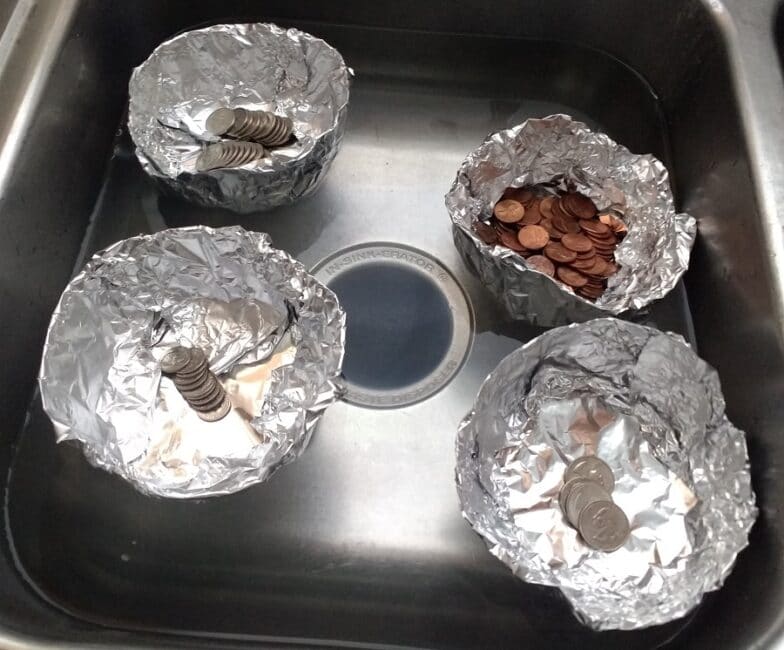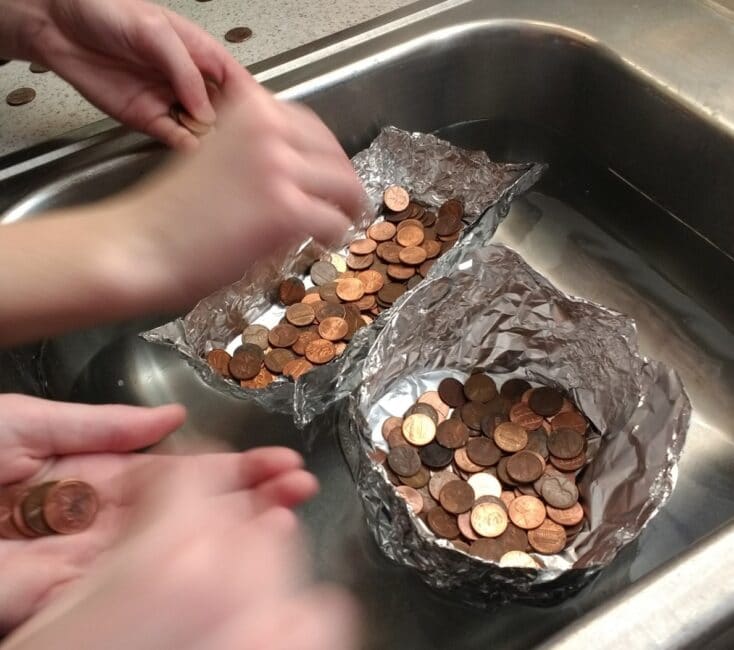Click here to read Easy Tin Foil Boat Money Float or Sink Experiment on Hands On As We Grow®
Work on counting money then dip into science with a tin foil boat float or sink experiment for President’s Day by Brigitte.

President’s Day is a great time to talk about US history. Making history real for kids is kind of hard though.
But money is very, very real – and many US presidents are on our coins!
I was inspired by Washington Crossing the Delaware, the famous Emanuel Leutze painting, while dreaming up this President’s Day activity. For this tin foil boat sink or float experiment, it’s all about the water.
Easy Tin Foil Boat Money Float or Sink Experiment
To get prepped for this tin foil boat experiment, you’ll need:
- coins
- aluminum foil
- bowls
- tub, big container, pot or sink
- water
We searched through our coin jars to find four presidents: Abraham Lincoln (pennies), Thomas Jefferson (nickels), Franklin D. Roosevelt (dimes), and George Washington (quarters).
We sorted the coins into piles while looking at the faces, talking about each president the whole time.
I did a rubbing of a penny, nickel, dime, and quarter to show the presidents’ faces along with their names. I had to do a second rubbing of a nickel when we noticed there are two different pictures for Thomas Jefferson.

Even children as young as three (with adult supervision) can practice sorting and matching the coins!
Add a Little History to Your Science Experiment
As we sorted and did coin rubbings, we also chatted about history. It is President’s Day, after all!
If you’d like to share some fast facts, talk about these:
- George Washington: on the quarter, 1st president and helped win the Revolutionary War
- Thomas Jefferson: on the nickel, 3rd president and wrote the Declaration of Independence
- Abraham Lincoln: on the penny, 16th president and was president during the Civil War
- Franklin D. Roosevelt: on the dime, 32nd president and the only president elected 4 times
While we talked and learned, my daughter decided to make her own “coins” by pressing aluminum foil around a couple of coins. She had seen the aluminum foil I had out for the next step and wanted to experiment.

Her coin copies turned out so much better than my coin rubbings!

Float or Sink? Tin Foil Boat Experiments to Test with Kids
After all of our talk about history and investigating the coins themselves, it was time to get down to experimenting. Up first: building tin foil boats for our float and sink experiment.
This is the reason the aluminum foil had been sitting out to begin with.
I used a plastic bowl as a mold so that all of the boats would be about the same size. Tear or cut a piece of aluminum foil slightly larger than the bowl.

Next, wrap the tin foil all the way around the bowl, tucking it in over the edge. Press down fairly firmly to really mold the foil to the bowl’s shape.

Then, I gently unwrapped the bowl just enough to remove it from the aluminum foil.

Finally, fold edges that had been in the bowl back in again so that the walls of the boat is really strong. Repeat four times to make four similar-sized tin foil boats.

Will the Tin Foil Boat Float or Sink?
My goal was to fill one with President Abraham Lincoln (pennies), one with President Thomas Jefferson (nickels), one with President Franklin D. Roosevelt (dimes), and one with President George Washington (quarters).
I thought it would be a fun science experiment to see what floats.
Our Challenge: Which presidential coin will we get more of in each boat before it sinks?
My plan changed when I realized we didn’t have enough quarters and dimes to actually sink the boats.
Here’s my original plan for the tin foil boat experiment:
- Count pennies into one tin foil boat, making tallies until the boat sank
- Repeat with nickels, dime, and quarters into the other tin foil boats
- Compare the different tally marks to see which boat needed to least coins to sink and the most coins to sink
- Talk about other things we observed
- Repeat with combos of coins or just float boats + coins around the water
All the Presidents Money Counting Tin Foil Boat Game for Kids
Okay, so my first idea didn’t quite pan out. I’m already on the hunt for more coins so we can actually do the tin foil boat float or sink experiment.
However, my activity plan didn’t totally fail since we were able to turn it into a cool money counting game!
First, we talked about how much each coin was worth:
- Penny = $0.01 or 1 cent
- Nickel = $0.05 or 5 cents
- Dime = $0.10 or 10 cents
- Quarter = $0.25 or 25 cents
Then, we talked about how to count to 100 with each coin and made a chart:
- Pennies: 100
- Nickels: 20
- Dimes: 10
- Quarters: 4
We counted out $1 worth of each of the coins. One hundred pennies and twenty nickels were easier to count when stacked in piles of ten.
Counting coins is great skip counting practice!
Slightly older kids might not need assistance counting, but be sure to lend a hand or have pre-portioned coins for the little ones.

With our kitchen sink filled with water, we put $1 worth of coins into each of the boats. They all floated!
President Abraham Lincoln’s boat and President Thomas Jefferson’s boat did get a little bit of water in them, though. It was fun to talk about why that might be with my kids.

Fun Twists to the Tin Foil Boat Money Float
My daughters didn’t want to stop there. They decided they each wanted to create their own tin foil boats.
One created her own round boat. She used the plastic bowl upside down as a mold.

My other daughter decided to create a long rectangular boat, freestyle.

They were both happy when their boats actually floated on the water. We did need to make some adjustments before everything was perfect, but it’s all part of the process.

They decided to put pennies into each of the boats one by one as we counted. It became a competition to see which boat could hold more of President Abraham Lincoln.
We considered some questions as they did this:
- How many pennies do you think you can get in your boat before it sinks?
- What happens if you stack all the pennies in one spot?
- Is it better if you spread the pennies across the bottom of the boat?
- Should we throw the pennies on the boat?
- Would it be better if we set the pennies gently on the boat?

We counted 169 pennies into each boat before we ran out of pennies. But neither boat sank.
So, we decided to just use one boat to see how many pennies it would take before it sank. The round boat ended up sinking with 267 pennies in it.

We switched and filled the rectangle tin foil boat, which ended up sinking with 185 pennies in it.

My daughters ended up experimenting for quite a while with the aluminum foil and water. They saw that their empty aluminum foil boats floated, but other objects sank.
We love this fun fireworks-theme science experiment, too!
Thankfully, George Washington’s boat was sturdier than our tin foil boat!
How do you blend different types of learning, like history and science? We’d love to check out your creative ideas!

0 Commentaires